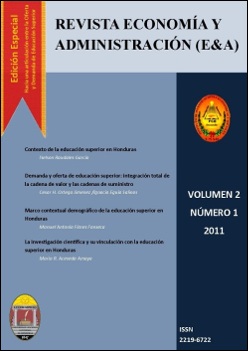Demanda y oferta de educación superior: Integración total de la cadena de valor y las cadenas de suministro
DOI:
https://doi.org/10.5377/eya.v2i1.4348Palabras clave:
Educación superior, Cadena de suministro, Cadena de valor, Demanda, Oferta, Profesional, Investigación, Vinculación con sociedad.Resumen
Para la demanda y oferta de educación superior (ES), se propone un modelo sistémico que integra una cadena de valor y dos de suministro de ES de Honduras, que incluye los insumos/entradas de ES (ej. graduados de educación media), el proceso de ES, las salidas/resultados de la ES. Para ello, se toman todos los actores de lo que podría ser considerado como un sistema de valor y de suministro de ES (proveedores de insumos, ofertantes/universidades y demandantes/ beneficiarios de resultados) para entender como sus interrelaciones contribuye al éxito de las operaciones de las tres funciones fundamentales de ES: docencia, investigación y vinculación con la sociedad. Así pues, la perspectiva holística considera tanto a una cadena de suministro de docencia (transferencia de conocimiento a estudiantes para convertirse en profesionales como parte del capital intelectual de ES), como a una cadena de suministro de investigación/proyecto (producción de conocimiento), así como una cadena de valor de la vinculación con la sociedad, que realimente el valor percibido de los resultados de ES (profesionales e investigación) entregados a sus demandantes. Así pues, dicha integración muestra no sólo el valor añadido por el proceso de la ES a ambos suministros (docencia e investigación), sino también la productividad de ambos, mejorando continuamente el flujo bidireccional ES-sociedad (Oferta y Demanda de ES). Todo ello como fundamento para investigaciones futuras, en un proyecto de ES en marcha, que permitan la articulación eficiente y eficaz entre proveedor de insumos, ofertante de ES y demandante de ES, guiada por la demanda (valor suplido al demandante) desde un modelo de un sistema de valor y de suministro con integración total (una ES articulada no sólo hacia adelante por la demanda, sino también hacia atrás por la oferta).
Descargas
2276
Descargas
Publicado
Cómo citar
Número
Sección
Licencia
Los autores que publican en esta revista están de acuerdo con los siguientes términos:
- Los autores conservan los derechos de autor y garantizan a la revista el derecho de ser la primera publicación del trabajo al igual que licenciado bajo una Creative Commons Attribution License que permite a otros compartir el trabajo con un reconocimiento de la autoría del trabajo y la publicación inicial en esta revista.
- Los autores pueden establecer por separado acuerdos adicionales para la distribución no exclusiva de la versión de la obra publicada en la revista (por ejemplo, situarlo en un repositorio institucional o publicarlo en un libro), con un reconocimiento de su publicación inicial en esta revista.
- Se permite y se anima a los autores a difundir sus trabajos electrónicamente (por ejemplo, en repositorios institucionales o en su propio sitio web) antes y durante el proceso de envío, ya que puede dar lugar a intercambios productivos, así como a una citación más temprana y mayor de los trabajos publicados (Véase The Effect of Open Access) (en inglés).




